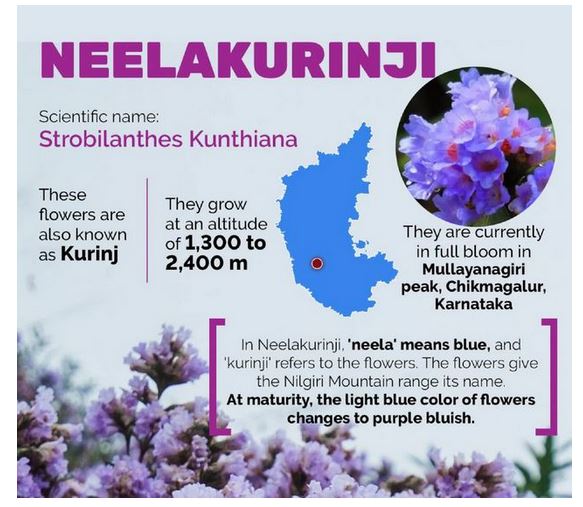Note4Students
From UPSC perspective, the following things are important :
Prelims level: Neelakurinji

Why in the News?
Neelakurinji has been categorized as Vulnerable in the IUCN Red List of threatened species for the first time under Criteria A2c.
About Neelakurinji (Strobilanthes kunthiana)
|
Details |
| Blooming Cycle |
- Blooms once every 12 years.
- Some bloom once every 7 years.
|
| Physical Description |
- Shrub that can grow up to 3 meters in height.
- Vibrant purplish-blue flowers bloom synchronously over large areas.
- Named after Kunthi River which flows through Kerala’s Silent Valley National Park.
|
| Habitat and Distribution |
- Endemic to high-altitude Shola grasslands of the Western Ghats.
- Found at elevations between 1,340 to 2,600 meters.
- Key regions: Nilgiris, Munnar, Palani-Kodaikanal, Anamalai mountains, and some isolated populations in the Eastern Ghats (Yercaud, Shevaroy Hills).
|
| Historical Blooming Records |
Documented blooming in 1838, 1850, 1862, 1874, 1886, 1898, 1910, 1922, 1934, 1946, 1958, 1970, 1982, 1994, 2006, and 2018. |
| Cultural Significance |
- Nilgiri Hills named after its purplish-blue flowers.
- Paliyan tribal people of Tamil Nadu used it to calculate their age.
|
| Ecological Importance |
- Critical for the biodiversity of montane grasslands.
- Provides nectar for pollinators during mass flowering.
|
PYQ:
[2011] The “Red Data Books” published by the International Union for Conservation of Nature and Natural Resources (IUCN) contain lists of
- Endemic plant and animal species present in the biodiversity hotspots.
- Threatened plant and animal species.
- Protected sites for conservation of nature and natural resources in various countries.
Select the correct answer using the codes given below:
(a) 1 and 3
(b) 2 only
(c) 2 and 3
(d) 3 only |
Get an IAS/IPS ranker as your 1: 1 personal mentor for UPSC 2024
Attend Now

